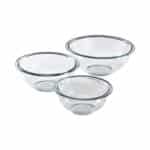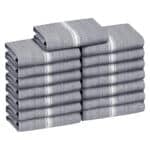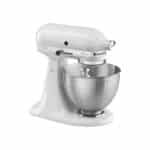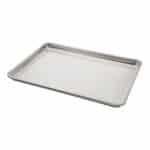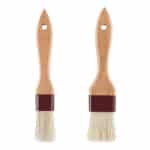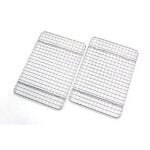During fall, when the last of the grapes are harvested, Italians make schiacciata all’uva (pronounced “ski-ah-cha-tah ahl ooh-vah”). It’s a sweet-savory grape focaccia, and here is our take on this Tuscan Grape Focaccia Recipe.
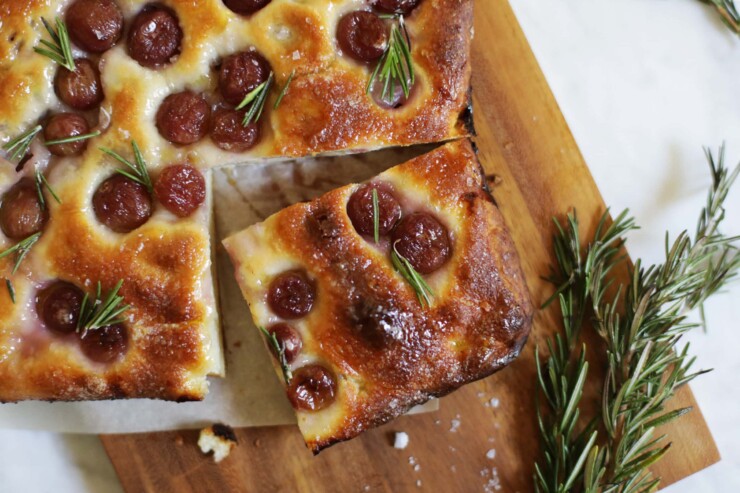
Why You’ll Love This Recipe
Back when I lived in Florence, I would hit up my local bakery, Forno Becagli, on the regular. Sometimes, I’d purchase a loaf of the traditional pane toscano, the unsalted Tuscan bread, to pair with dinner. Other times, I’d stop in for a slice of their pizza as an afternoon snack.
But most often, it was to get some of their crispy, salty schiacciata flatbread or Tuscan Grape Focaccia. This is one of those not-too-sweet, not-too-salty recipes that works as a snack, a dessert, or a quick breakfast.
Recipe Ingredients
These are the ingredients you’ll need to make this recipe:
For The Schiacciata Focaccia Dough:
- 00 flour or all-purpose flour
- whole milk
- warm water
- active dry yeast
- kosher salt
- extra-virgin olive oil
For The Schiacciata Filling:
- Concord grapes or Champagne grapes or blueberries
- granulated sugar
- Large pinch of Maldon sea salt or other flaky sea salt
- fresh rosemary leaves
How To Make The Tuscan Grape Focaccia
These are the instructions to make this recipe:
- Make The Schiacciata Dough: Similar to a classic focaccia sought, you’ll make a starter, then make a dough that needs to rise a few times.
- Let The Dough Age: For maximum flavor, you’ll want to let this dough rest for up to 48 hours before baking it.
- Shape The Tuscan Grape Focaccia: When ready to bake, you’ll warm up the oven and the dough. Then, you’ll roll the dough into two rectangles and sandwich the grapes in between.
- Bake The Schiacciata: Then bake the focaccia until it’s golden brown. Let it rest then brush with more olive oil before serving.
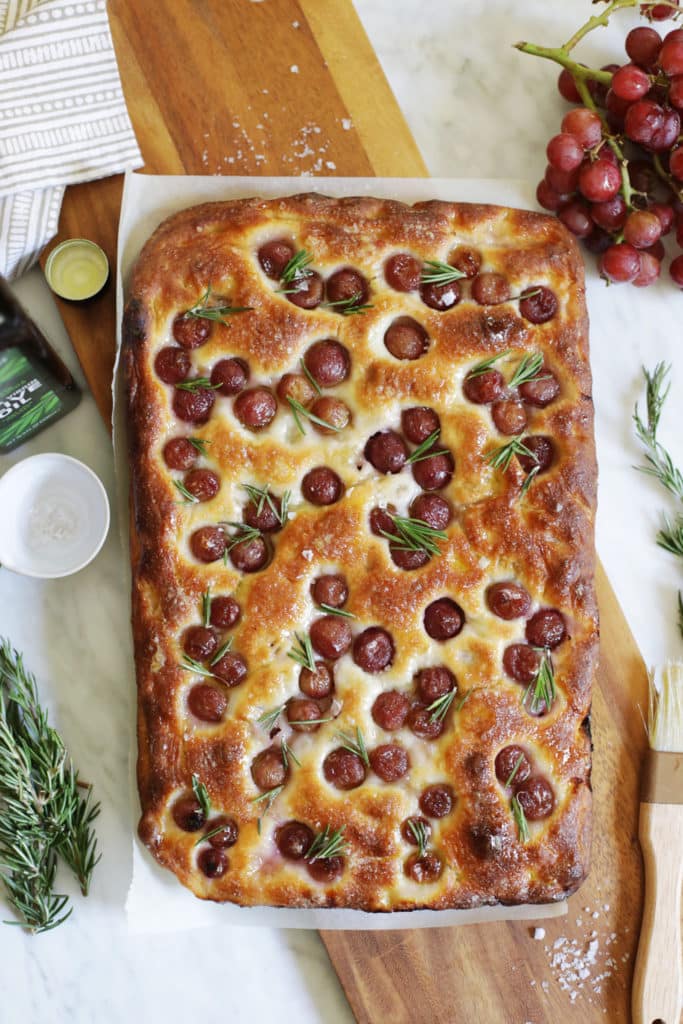
What Is Schiacciata?
Schiacciata is one of the most classic Tuscan foods. It is a Tuscan version of focaccia that is found all over the central regions of Italy. Unlike the better-known focaccia you get in Genoa, this version is often thinner and ends up a bit more crunchy than doughy. The difference from the Genoa style focaccia? It comes down to the technique. The term schiacciata means “squashed” or “pressed,” so, when you make the Tuscan version of focaccia, you do just that by pressing the dough down with your fingers.
The simplest, most common version is topped with olive oil and eaten as is or sliced up for sandwiches. Some versions have some rosemary on top and other versions are sweet-savory take on the traditional schiacciata like this one made with grapes. The sweet-savory variations are seasonal and less common and another version we like is made with figs.
So, What Is Schiacciata All’Uva?
During the fall harvest, the last of the wine grapes were traditionally used to make schiacciata all’uva. Translating to “smashed bread with grapes” this focaccia is a twist on the classic unsalted Tuscan focaccia known as schiacciata.
Unlike the thin, single layered traditional schiacciata, this version is made by making a double-layer of bread with grapes sandwiched between the layers and scattered across the top. The result is a grape-studded bread with a sweet-savory jammy flavor that screams Fall.
Traditional schiacciata all’uva is a sweet-savory focaccia made with nothing more than grapes, olive oil, and sugar. And, in Italy, this is often made with an unsalted dough (as is traditional in so many breads throughout the region) and with grapes that have seeds in them (locals like the crunch the seeds provide).
Our recipe adds in salt because we really believe it provides a more complex flavor and we say try it once with grapes that have seeds in it to see if you do or don’t like that style. Also we top it with some fresh rosemary and a bit of flaky sea salt because we think it really helps amp up the final flavor.
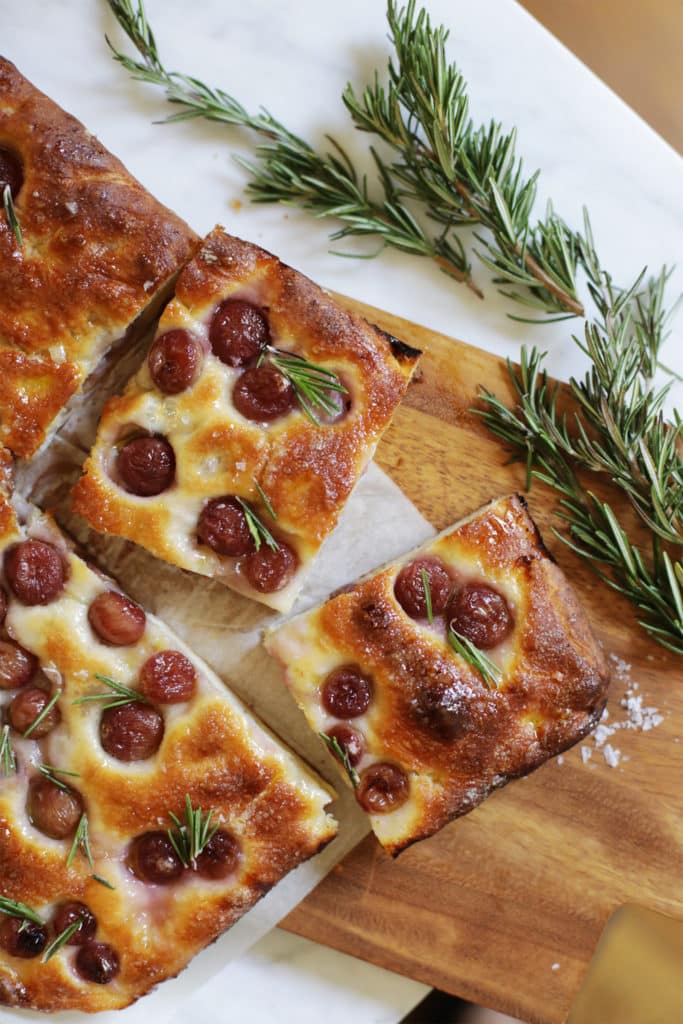
What Kind Of Grapes Do You Use For Schiacciata All’Uva?
In Tuscany this bread was traditionally made as a means to use up leftover grapes from harvest. Over time the go-to grapes to make it were the naturally sweet and fragrant Canaiola. These grapes are pretty much impossible to find in the United States outside of a winery but, luckily, there are a couple alternatives.
Most versions of this recipe will suggest you use Concord grapes, which are perfect for their small size, jammy flavor, and their water ratio. But they can only be found a few weeks out of the year and, even then, are hard to find.
Another option we’ve found works great are the small grapes known as Champagne grapes, which we come across at our gourmet grocer. And, finally, you can use red seedless Flame grapes as we’ve done here but you want to go for the smallest you can find. We’d suggest you steer clear of bigger grapes like Globes that have so much moisture that they tend to make the bread too wet and make it hard for it to properly bake.
Or, as Emiko suggests, you could even use fresh blueberries for what we imagine would be a delicious (if untraditional) twist.
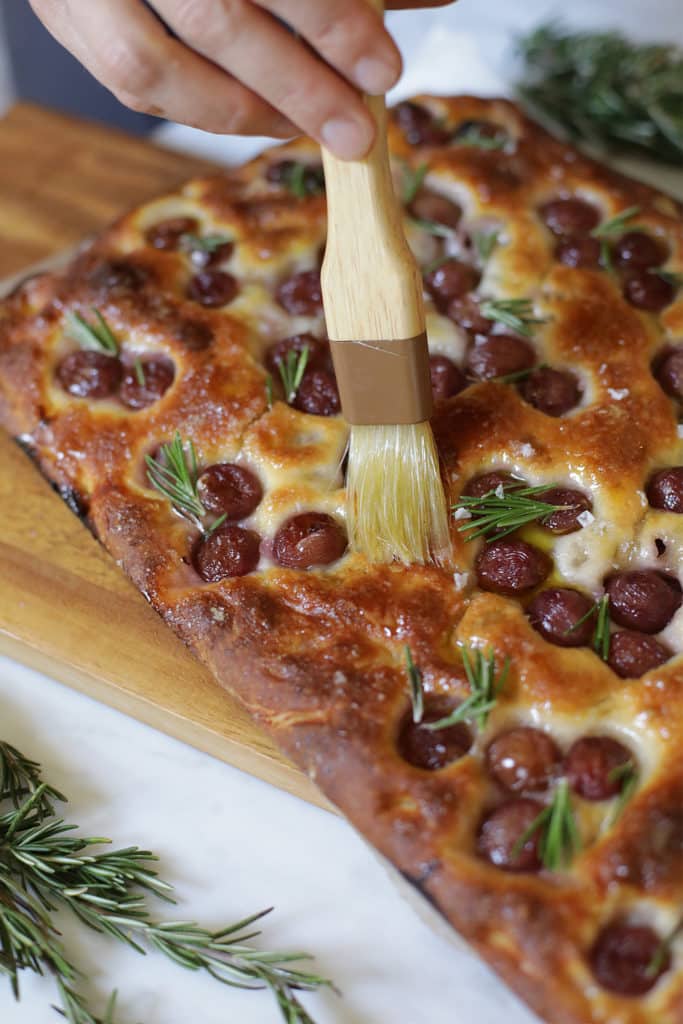
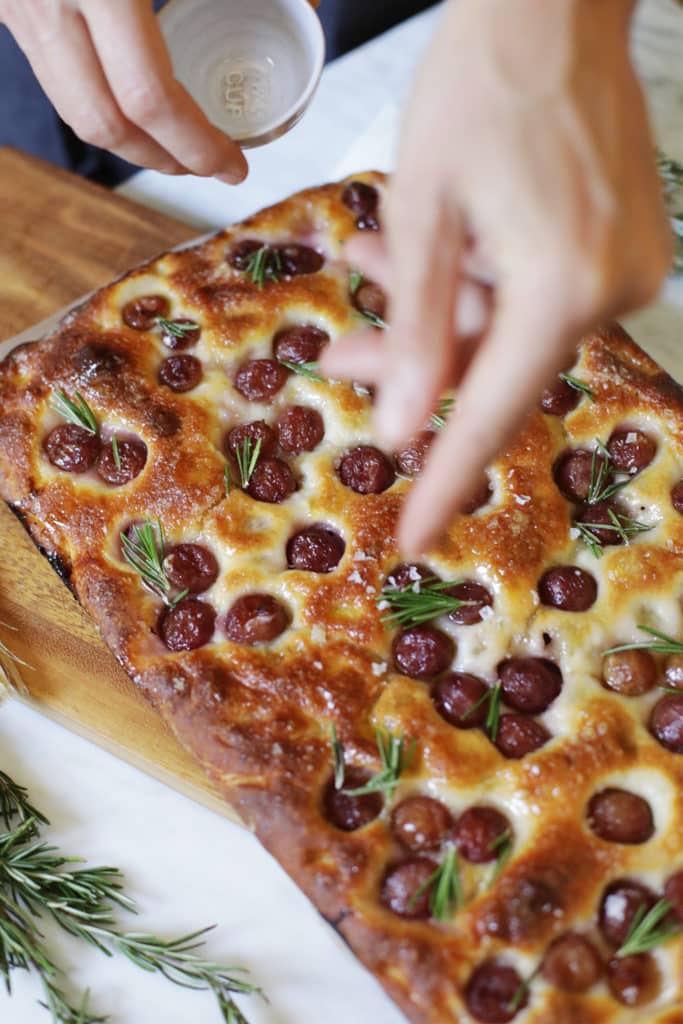
4 Tips For Making Schiacciata All’Uva
If you’ve made our Genoa style focaccia, you’ll notice that there are some similarities here when it comes to technique. Both require time and patience, but, when it comes to technique, it’s really quite simple to make. Even so a few key tips will help make this focaccia a success every time:
Let It Overnight Rise
You’ve heard us say this time and again! From our cookies to pizza dough and focaccia, we’re fans of the long rise. Letting doughs rise in the refrigerator for anywhere from 8 to 48 hours means it has a more slow rise and a more complex flavor. If you don’t have time for that, you can still make this bread — let it rise at room temperature in a draft free, warm spot until it has doubled in size about 90 to 120 minutes.
Smash It Down
With our Genoa-style focaccia we do multiple rises to help the final bread rise to great heights! Here we do one long rise and then actually are going to smash that down. But there is a best way to do this so that you don’t lose all the long rise height and still get the traditional Tuscan texture.
Let It Warm Up Before Rolling
We recommend bringing the dough out of the fridge and letting it sit until it’s warmed up enough to be workable (you will be able to stretch it without it snapping back), about 20 to 30 minutes. Then immediately proceed to roll out and assemble the schiacciata. The end goal is that the dough will rise as it bakes but ultimately won’t get any higher or thicker than about 1 to 1 1/2 inches in height.
Brush With Olive Oil
Don’t be afraid of really adding a serious amount of olive oil as it provides flavor and moisture to the dough. Even when it comes out of the oven and is done baking you’ll want to do a final olive oil drizzle and add the rosemary leaves so that they infuse the focaccia as it cools.
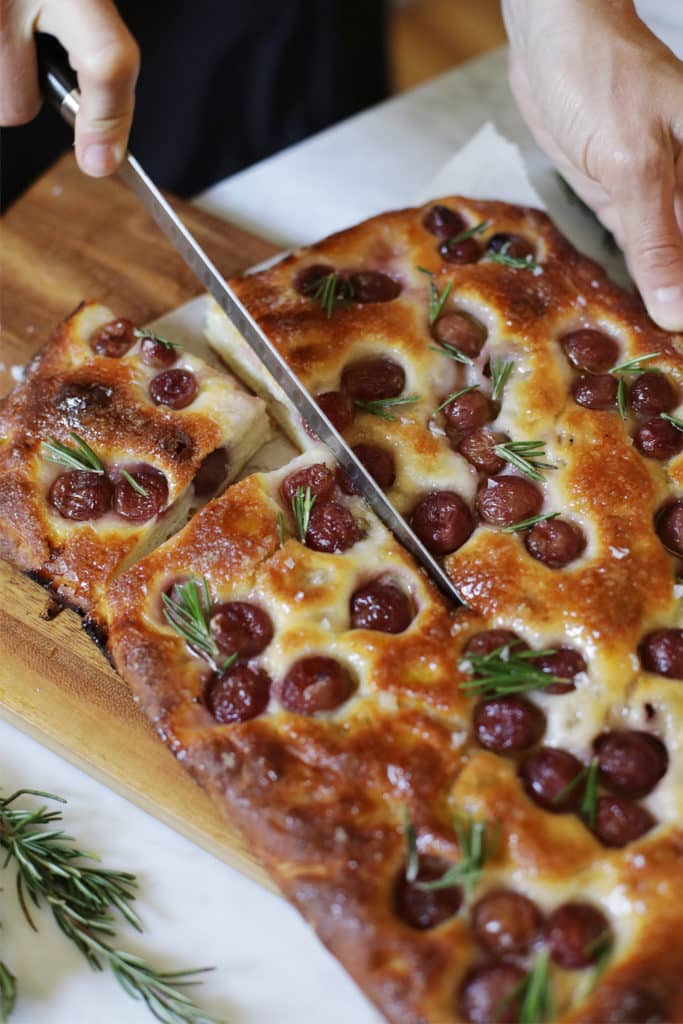
What To Serve With Tuscan Grape Focaccia
So, here’s the thing. In Italy, you’d eat this as is, and it is delicious. However, through the years, I’ve served it with all sorts of things, including cut up into small squares as part of a cheeseboard (it’s delicious with blue cheese or goat cheese), served it with curls of prosciutto on top of the sweet-savory contrast. I’ve even topped it with a scoop of ice cream drizzled with olive oil for dessert!
Go stock up on all your cooking essentials, head into the kitchen, make this, and share it with us by tagging @saltandwind and #swsociety on social!
Frequently Asked Questions
Tuscan Grape Focaccia, also known as Schiacciata con l'uva, distinguishes itself by its unique incorporation of grapes into the dough. This traditional Italian bread is characterized by its sweet and savory flavor, where the juiciness of the grapes contrasts with the earthy rosemary and the crunchy sea salt topping. It's typically made during the grape harvest season, using local grape varieties.
For an authentic Tuscan Grape Focaccia, it's best to use wine grapes, such as Sangiovese, which are traditional in Tuscany. However, if these are unavailable, other varieties like Concord or black grapes can also be used. Choosing grapes that are relatively firm and not overly sweet is important to balance the flavors in the focaccia.
Yes, Tuscan Grape Focaccia can be made gluten-free by substituting regular flour with a gluten-free blend. It's advisable to look for a blend designed for bread baking to ensure the focaccia has a suitable texture. Also, adding xanthan gum might be necessary to mimic the elasticity and stickiness of gluten.

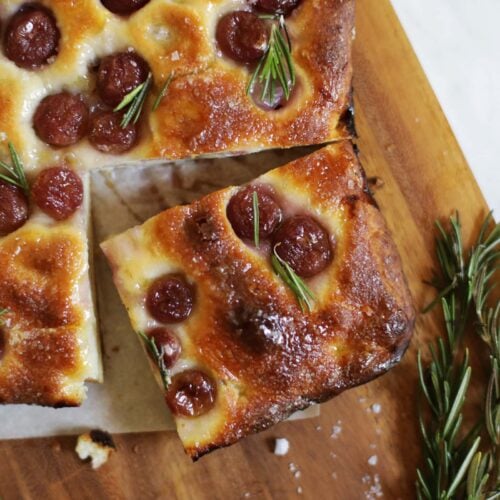
Tuscan Grape Focaccia Recipe
Equipment
Ingredients
For The Schiacciata Focaccia Dough:
- 3 1/2 cups 00 flour or all purpose flour
- 1 cup whole milk
- 1/2 cup warm water
- 1 teaspoon active dry yeast
- 1/2 teaspoon kosher salt (optional)
- 6 tablespoons extra-virgin olive oil divided plus more for garnish
For The Schiacciata Filling:
- 1 pound (about 4 cups) Concord grapes or Champagne grapes or blueberries
- 4 tablespoons granulated sugar
- Large pinch Maldon sea salt or other flaky sea salt, for garnish
- 3 to 4 sprigs fresh rosemary leaves for garnish
Instructions
- Make The Schiacciata Dough: Stir together the 1 teaspoon of yeast and 1/2 cup of the warm water and set it aside until it's starting to bubble, about 5 minutes. Meanwhile, combine the 3 1/2 cups of flour and the 1 cup of milk in the bowl of a stand mixer fitted with the dough hook. Mix on low speed until a shaggy dough forms, stopping a few times to scrape down the inside of the bowl to incorporate any dry flour. Stop the mixer, add in the yeast and water mixture, and mix on low speed until the dough is evenly hydrated and moistened. Add the optional 1/2 teaspoon salt, if using, and 2 tablespoons of the olive oil, one tablespoon at a time.Mix on medium speed until the mixture comes together as a dough (when you add the oil it will look like it isn't going to combine with the dough but just let the mixer keep going -- it will all mix in!). Continue to mix on medium speed until the dough is smooth and does not stick to the sides of the bowl, about 5 to 8 minutes. Remove the dough to a barely floured clean countertop and bring it together in a ball. Meanwhile, add a drizzle of oil to a large mixing bowl, add the dough and turn it to coat in the oil, then cover it with a clean kitchen towel or plastic wrap and refrigerate it for 8 to 48 hours.
- Shape The Schiacciata Bread: Once you are ready to bake the focaccia, bring it out of the refrigerator and let it sit in a warm place until you can work with it, at least 15 minutes. Heat the oven to 450°F, arrange a rack in the middle, and, place a baking stone, pizza stone, or two nested baking sheets on the rack (these will help make the bottom crust nice and golden brown!). Meanwhile, shape the focaccia by dividing the dough in two equal parts. Brush a little extra (not the measured!) olive oil onto a 13-by-9-inch rimmed baking sheet or glass baking pan. Take one piece of the dough and, with a lightly floured rolling pin, roll it into a 1/2 inch thick rectangle. Place the dough in the baking sheet and push it into the corners then use your three middle fingers on each hand to create dimples in the dough (you should make indentations that go about 2/3 down but don't hit the bottom of the pan and don't tear the dough). Scatter half of the grapes on the dough, leaving a 1/2 inch border on all sides. Drizzle with 2 tablespoons of the olive oil and 2 tablespoons of the sugar then top with a generous pinch of the flaky sea said.Repeat that to create a second layer and use up the remaining dough, grapes, 2 tablespoons sugar, and 2 tablespoons olive oil.
- Bake The Schiacciata: Place the focaccia in the oven on the baking stone or baking sheets, reduce the oven temperature to 425°F, and bake 35 to 40 minutes, turning halfway through baking. Once the focaccia is golden brown on the top and bottom (it should have a minimum internal temperature of 190°F), remove it from the oven and set it aside to cool for 5 to 10 minutes.Remove the focaccia from the pan and place it on a cooling rack set inside a baking sheet to cool. Use a pastry brush to add a drizzle more of oil then scatter the leaves of a few sprigs of rosemary and a large pinch of flaky sea salt over the top. Serve while the schiacciata is warm or at room temperature.
